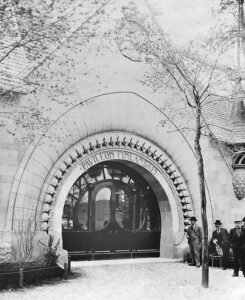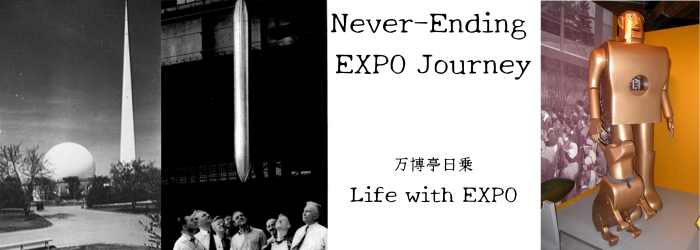In the previous article, I introduced the news of Finland’s entry into NATO, the impact of Russia’s invasion of Ukraine on the 2030 World Expo, and the status of candidate countries for the 2030 World Expo.
In fact, Finland has been under pressure from Russia since before, not just this time.
There is an Expo where you can understand this well.
1900 Paris World Exposition.
The 1900 Paris World Exposition, the largest exhibition of the 19th century
Speaking of the 1900 Paris World Exposition (April 15th to November 12th, 1900), it was the last and the largest World Exposition in the 19th century which celebrated the end of the 19th century.
This is the Expo where Art Nouveau became very popular.
The theme of the Expo was “Evaluation of a Century“.
At this huge Expo, which attracted more than 50 million people, the second Modern Olympics were held.
In addition, two museums, the Grand Palais and the Petit Palais, were built on the occasion of this Expo, and the Alexandre III Bridge with its beautiful gold decoration was also built at this time.
In addition, Victor Laloux designed the Orsay Station for the Expo, which was completed in July 1900.
At that time, it was called Orléans New Station.
In 1986, this station was reborn as the Musée d’Orsay, reusing the station building.
Also, on July 14, about three months after the Expo began, the “Line 1″ Subway connecting the new Orléans Station and Porte de Vincennes was opened.
The venue of the Expo was also huge, divided into the main venue in Paris and the Vincennes sub-venue.
1900 Paris World Exposition “Finnish Pavilion”
Within the venue, there was the Foreign Pavilion Zone on the south side of the Seine River.
In the Foreign Pavilion Zone, facing south from the Seine River, sandwiched between two large pavilions, the Norwegian Pavilion on the left, and the German Pavilion on the right, you can see the Finnish Pavilion along the back street. ”.
The “Finnish Pavilion” was not built along the Rue des Nations along the Seine River, where the main Nations’ Pavilions line up, but along a street called Quay D’Orsay, just inside the Rue des Nations.
When viewed from the Seine, it was sandwiched between two pavilions: the Luxembourg Pavilion on the left and the Bulgarian Pavilion on the right.
The designer of this acclaimed pavilion was Eliel Saarinen (1873 – 1950).
Saarinen is a Finnish-born architect.
When he was studying architecture at the University of Helsinki, he and two of his schoolmates founded the architectural design office Geselius, Lindgren, Saarinen (GLS Architectural Design Office).
Their proposal for the Finnish Pavilion for the 1900 Paris International Exposition was selected for the competition.
At that time, Finland was under Russian rule and was considered a part of Russia.
However, in Finland, an ethnic cultural movement called “National Romanticism“, which sought independence from Russia, was flourishing.
Saarinen, who designed the Finnish Pavilion, and his lifelong friends, the composer Jean Sibelus (1865 – 1957) and the painter Axeli Gallen-Carrera (1865 – 1931), were also enthusiastic promoters of the movement.
Sibelius likened imperial Russia to a dark night and composed “Finlandia”, which symbolizes the Finnish independence movement. It is said that this was composed as the final chapter of the music for the historical drama “Kalevala“, which is based on the Finnish folk epic “Kalevala”.
By the way, “Kalevala” means “the land of the warriors of the Kaleva tribe,” and was compiled from folk tales by a doctor and published in 1835.
It can be said that this work shows the origin of Finland, from the creation of the world to the arrival of Christianity in Finland.
This work would eventually become the major cultural foundation that led to Finland’s independence from Russia in 1917.
Participation of Axeli Galen-Carrera
On the other hand, Axeli Galen-Karela participated in the Finnish Pavilion together with Saarinen, and the concept at that time was also an element of this “Kalevala”-like Finnish unique culture.
It could be said that the pavilion was filled with the Finns’ desire to somehow become independent from Russian rule.
The Finnish Pavilion was a small pavilion with a total floor area of about 365 square meters.
In the 2005 EXPO AICHI, JAPAN , the smallest pavilion type had 324 square meters (18m x 18m), which is the pavilion of ‘one module’, so Finnish Pavilion at 1900 Paris Exposition seems to be about the same scale as the smallest pavilion type of 2005 Aichi Expo.
However, the pavilion was highly acclaimed, and it is said that there was an increase in media support for Finland’s independence.
Pressure from Russia
As a matter of fact, the Finnish Pavilion was under pressure from Russia, and it seems that the Russian side requested that “Russian Section” be displayed on the left and right of the gate of the pavilion.
Therefore, the Finnish side made a device that could retouch the sign and countered the control from Russia.
In addition, it is said that media measures such as distributing photographs with only the sign of “Finland Pavilion” were distributed to the media.
Furthermore, for example, if you look at the overall photo of the Finnish Pavilion, which is used in the featured image of this post and is thought to be the most widely distributed, it is angled so that the top of the tower cannot be seen. In fact, it seems that a “double-headed eagle” was installed at the top of this tower.
Needless to say, the “double-headed eagle” is the Russian coat of arms, and this was due to Russian pressure.
The Finnish side deliberately circulated photographs that removed it from the angle of view to the media.

フィンランド館の入り口
Finnish pavilion entrance
As a result, the pavilion was highly acclaimed, won the Grand Prix (although, by regulation, this award was given to Russia), and Finland achieved independence from Russia 17 years later.
In addition, furniture such as the “Iris Chair” exhibited in the “Iris Room”, designed by Axeli Gallen-Carrera, and textiles were highly acclaimed, and these exhibits won multiple awards at the Paris Expo.
Axeli Galen-Carrera was also awarded a gold medal at the Expo.

イーリスの間
Iris Room
Finland and the Expo
Finland joined the BIE on July 3, 1937.
According to the BIE homepage, it mentions as follows;
“Finland joined the BIE in 1937, and a year later the Specialised Exposition was organized on the theme of Aerospace, the 1938 Helsinki Exposition. (Specialized Expo 1938 in Helsinki)
Finland continues to be an active participant in Special and World Expositions, and at the 2010 World Expo in Shanghai, the Finnish pavilion won a Gold Medal in pavilion design”
After the Shanghai Expo 2010, the Finnish Pavilion won the Gold Prize at the Astana Expo 2017 and the Silver Prize at the Dubai Expo 2020.
Don’t miss Finnish exhibits at future Expos, such as the Osaka Kansai Expo 2025.
(As of March 24, 2023, Finland has not yet announced its participation in the 2025 Osaka Kansai Expo. On the other hand, Russia has announced its participation.)
According to the BIE website, the 1938 Helsinki World Exposition was held from May 14th to May 22nd (that is, only 9 days!), and was attended by 25 countries.
It seems to have been a small expo.
Well, Eliel Saarinen, the architect who designed the Finnish Pavilion, later went to the United States, and his son Eero Saarinen also played an active part in the Expo, but I will leave that story for another time. .


